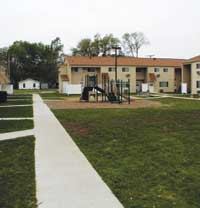Nowhere to Turn
Celina Gardens, a 32-unit property in Celina, Ohio, might be the epitome of what’s happening with the Section 515 properties, the majority of which are located in the Midwest. Built in 1976, Celina Gardens had tile floors, baseboard heating, small units, and no air conditioning–among other ailments. “The natural light is very, very poor,” says Steve Boone, president of Cleveland-based Buckeye Community Hope Foundation, which developed Celina Gardens and other USDA Rural Development low-income housing tax credit properties.
Celina Gardens isn’t alone in its plight. Many of the country’s 1,700 Section 515 properties (which adds up to 450,000 units) face the same challenges. “They need repair work,” Wagner says. “Most of these things deal with the age of projects. A project built 25 years ago may not have grab bars, a call system, and handicap accessibilities that would be typical today.”
The problem: Celina Gardens and its fellow Section 515 properties don’t have enough cash. “They don’t have reserves for repair work,” Wagner says. “They have insufficient funds to do rehabs and repairs that they need to do, and they can’t replace systems that are 15 to 20 years old.”
With a market-rate property, a landlord would just rehab the building and increase the rents. But that’s difficult with Section 515 apartments. “They can’t raise the rents in a fashion that would generate enough reserves to do [a rehab] because they rent to very low-income families,” Wagner says.
And, since many of these properties are small, it’s a challenge for them to secure the necessary financing in a market that favors bigger deals. “The largest challenge is one of scale,” says Adam I. Galowitz, vice president in charge of strategic asset management for Recap Advisors, a Boston-based company that provides financial services related to the recapitalization and preservation of affordable housing. “It’s very difficult to bring conventional capital market sources to a 24-unit deal in a single market.”
Another problem: the lack of information on comparable rents. Since Section 515 properties are in rural areas, their closest competitor is often hundreds of miles away. “That presents a huge problem in underwriting,” Galowitz says. “If you have to go 200 miles to the next town to get a competitive market rent, you have a real problem convincing a syndicator or debt financing source what your underlying real estate value is.”
